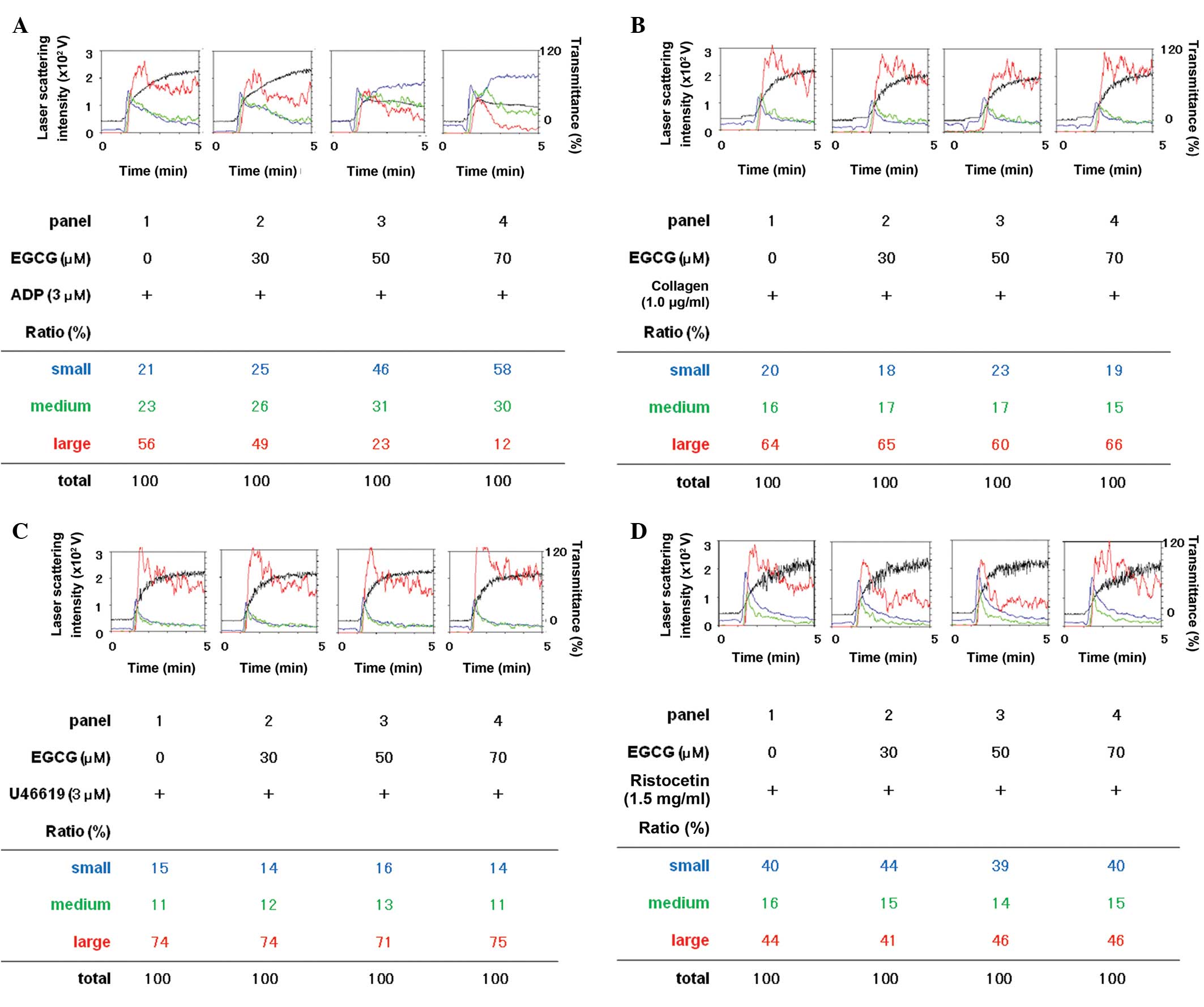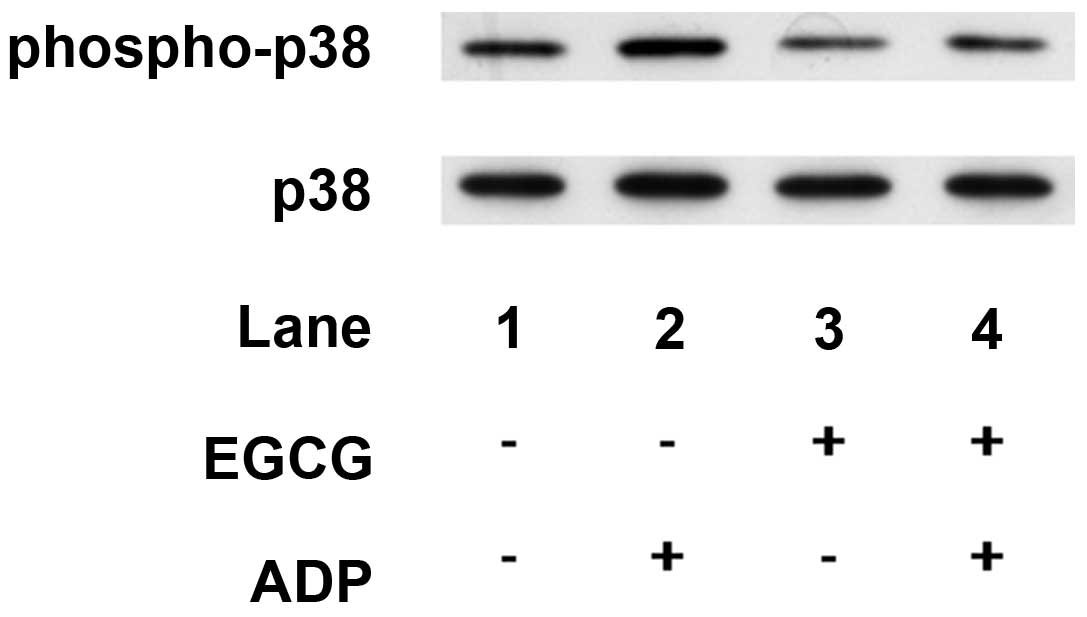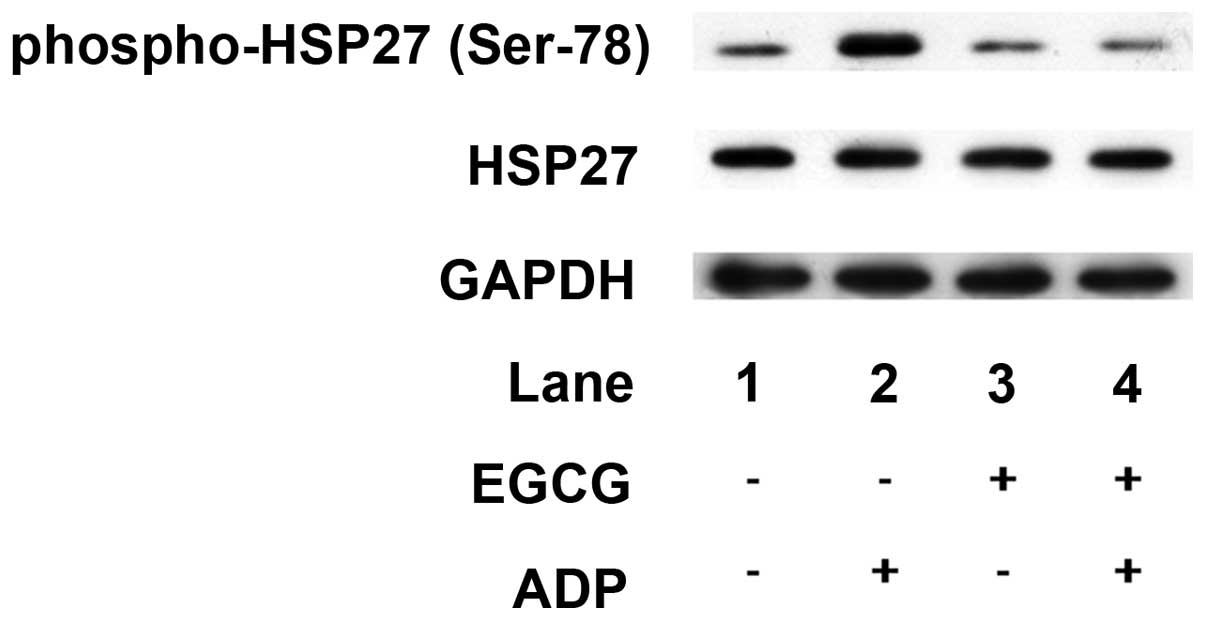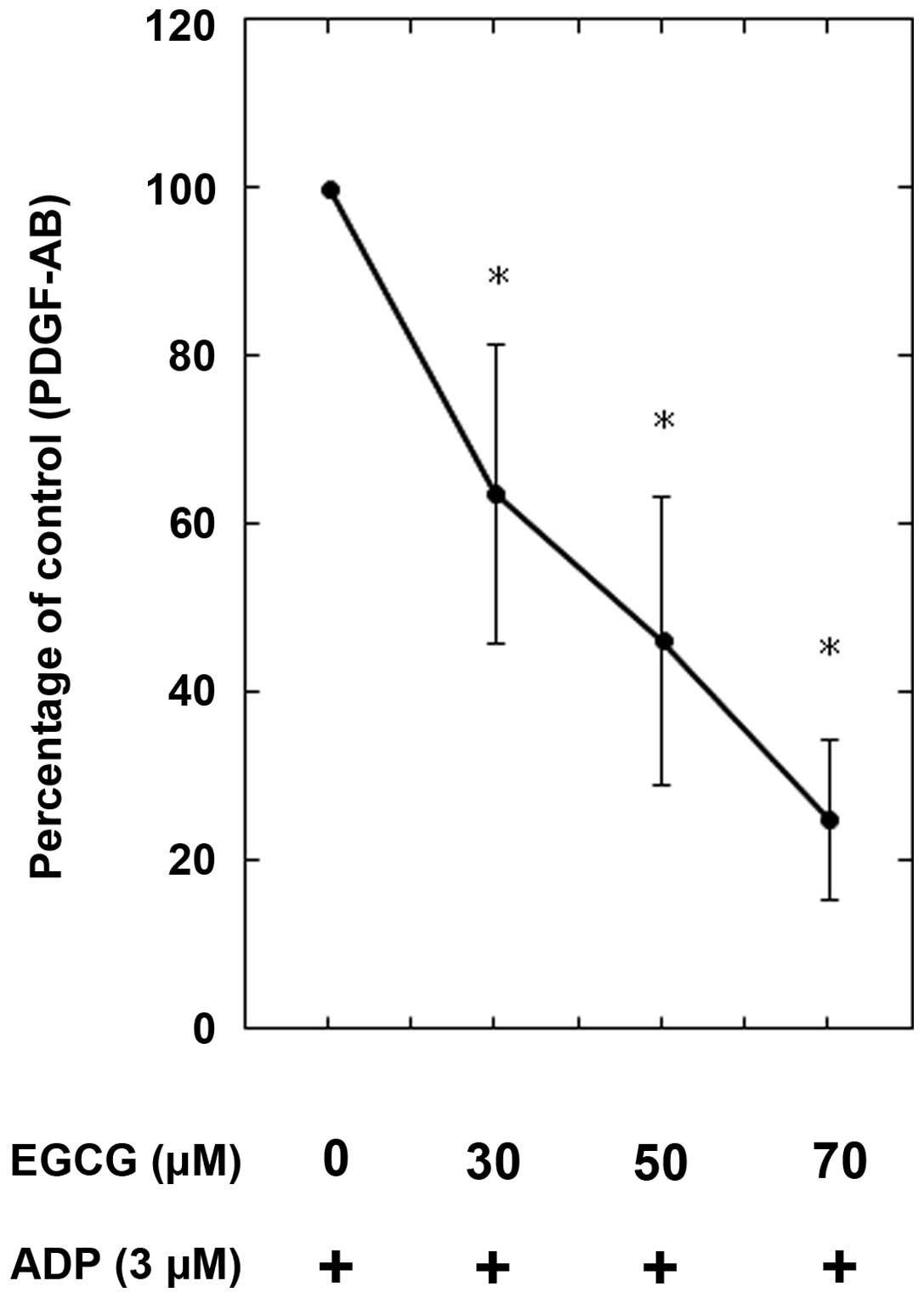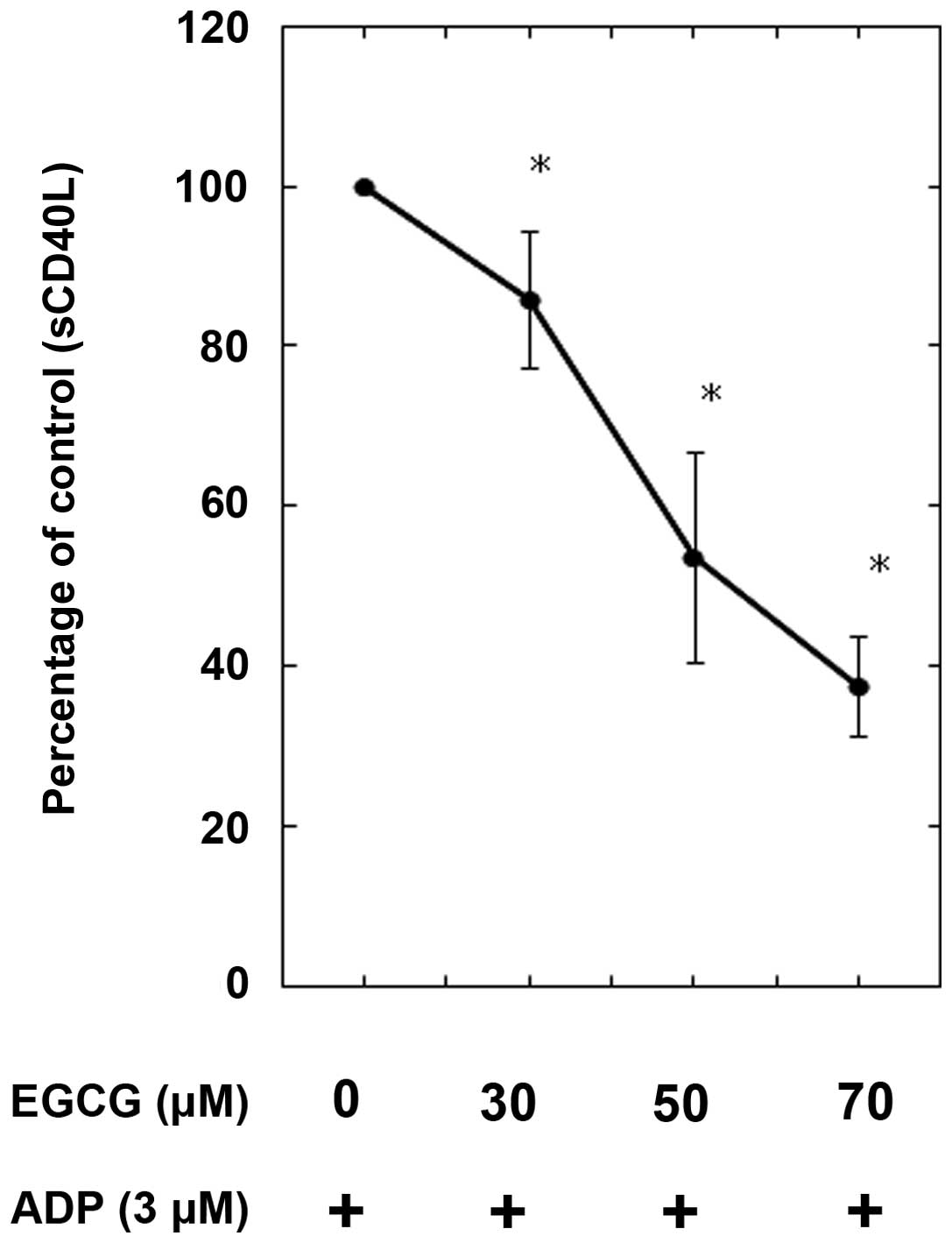(-)-Epigallocatechin gallate selectively inhibits adenosine diphosphate‑stimulated human platelet activation: Suppression of heat shock protein 27 phosphorylation via p38 mitogen‑activated protein kinase
- Authors:
- Published online on: July 16, 2014 https://doi.org/10.3892/mmr.2014.2389
- Pages: 1383-1388
Abstract
Introduction
Catechins are important components of green tea polyphenols with numerous favorable biological functions, including anti-inflammatory, anti-oxidative, anti-atherosclerotic, anticarcinogenic and anti-arthritic effects in humans (1–3). Green tea mainly contains four catechins, epicatechin, epigallocatechin, epicatechin gallate and (−)-epigallocatechin gallate (EGCG), and among them EGCG is the most abundant (4).
Platelets are important in primary hemostasis and the repair of vascular injury. Platelet adhesion and platelet aggregation are important steps in thrombus formation. Platelets initially adhere to the vessel wall at the sites of endothelial cell activation and develop into chronic atherosclerosis via adhesive receptors, including glycoprotein Ib/IX/V receptors, which mediate rolling and tethering of the platelets to von Willebrand factor at the sites of vascular injury and induce glycoprotein IIb/IIIa activation and the release of adenosine diphosphate (ADP), resulting in platelet aggregation (5–7). In addition, platelets engage collagen in the vessel wall through their adhesion receptors glycoprotein Ia/IIa (8). The interaction of von Willebrand factor and glycoprotein Ib/IX/V is known to be induced by ristocetin, an activator of glycoprotein Ib/IX/V (9). It has been reported that ristocetin-induced glycoprotein Ib/IX/V activation leads to the generation of thromboxane A2 (TXA2) in platelets (7). ADP enhances platelet activation by engaging specific GTP-binding protein coupled receptors, P2Y1/P2Y12 receptors, and activates glycoprotein IIb/IIIa and the cyclooxygenase (COX)-1 pathway, resulting in the stimulation of platelet aggregation (10,11). Then activated platelets release inflammatory agents, including soluble CD40 (sCD40) ligand and secrete mitogenic mediators, including platelet-derived growth factor (PDGF)-AB from granules into the local microenvironment. Previous studies (12,13) demonstrated that ADP induces heat shock protein 27 (HSP27) phosphorylation via p38 mitogen-activated protein (MAP) kinase and p44/p42 MAP kinase in human platelets, and is also associated with the secretion of PDGF-AB and the sCD40 ligand. In addition, it has been demonstrated that ristocetin stimulates the release of the sCD40 ligand from human platelets through TXA2-mediated activation of the TXA2 receptor and that release of the sCD40 ligand via TXA2 generation from platelets in atherosclerotic patients is elevated (14). Regarding the effect of EGCG on human platelets, it has been reported that EGCG exhibits a potent antithrombotic effect by the inhibition of platelet aggregation (15). However, its precise mechanism in human platelets has not yet been elucidated.
The present study examined the effects of EGCG on human platelet activation by various stimulators, including ADP, collagen, ristocetin and the TXA2 receptor agonist, and the exact mechanisms underlying the effect of EGCG. The present study also demonstrated that EGCG selectively inhibits ADP-stimulated human platelet activation and that EGCG reduces PDGF-AB secretion and sCD40 ligand release due to the suppression of HSP27 phosphorylation via p38 MAP kinase.
Materials and methods
Materials
EGCG, ADP, U46619 and ristocetin were purchased from Sigma-Aldrich (St. Louis, MO, USA). Collagen was purchased from Nycomed Pharma GmbH (Munich, Germany). PDGF-AB enzyme-linked immunosorbent assay (ELISA) kits and sCD40 ligand ELISA kits were purchased from R&D Systems (Minneapolis, MN, USA). Phospho-specific anti-p38 MAP kinase antibodies, p38 MAP kinase antibodies and phospho-HSP27 (Ser-78) antibodies were obtained from Cell Signaling Technology, Inc. (Beverly, MA, USA). Anti-HSP27 antibodies and GAPDH antibodies were purchased from Santa Cruz Biotechnology, Inc. (Santa Cruz, CA, USA). The other materials and chemicals were obtained from commercial sources.
Preparation of platelets
Human blood was donated from healthy volunteers into 1/10 volume of 3.8% sodium citrate. Platelet-rich plasma (PRP) was obtained from blood samples by centrifugation at 155 × g for 12 min at room temperature. Platelet-poor plasma (PPP) was prepared from the residual blood by centrifugation at 2,500 × g for 5 min. All participants signed an informed consent agreement following receiving a detailed explanation and the study was approved by the Committee of Ethics in Gifu University Graduate School of Medicine (Gifu, Japan).
Platelet aggregation
Platelet aggregation using citrated PRP was followed in a PA-200 aggregometer (Kowa Co. Ltd., Tokyo, Japan), which is able to determine the size of platelet aggregates based upon particle counting using laser scattering methods (small size, 9–25 μm; medium size, 25–50 μm; large size, 50–70 μm) (16), at 37°C with a stirring speed of 800 rpm. The platelets were pre-incubated for 1 min and then platelet aggregation was monitored for 4 min. The percentage of transmittance of the isolated platelets was recorded as 0% and that of the appropriate PPP (blank) was recorded as 100%. When indicated, PRP was pretreated with EGCG for 15 min.
Protein preparation following stimulation
Following stimulation with ADP, collagen, ristocetin or U46619, platelet aggregation was terminated by the addition of an ice-cold EDTA (10 mM) solution. The mixture was centrifuged at 10,000 × g at 4°C for 2 min. In order to measure PDGF-AB and the sCD40 ligand as described below, the supernatant was isolated and stored at −30°C for subsequent ELISA. For the western blot analysis of p38 MAP kinase and HSP27, the pellet was washed twice with phosphate-buffered saline and then lysed and immediately boiled in lysis buffer containing 62.5 mM Tris/Cl, pH 6.8; 2% sodium dodecyl sulfate (SDS), 50 mM dithiothreitol and 10% glycerol.
Western blot analysis
A western blot analysis was performed as described previously (17). Briefly, SDS-PAGE was performed by the method described by Laemmli (18) in a 10% polyacrylamide gel. The proteins in the gel were transferred onto polyvinylidene fluoride (PVDF) membranes, which were then inhibited with 5% fat-free dry milk in Tris-buffered saline with 0.1% Tween-20 (TBST; 20 mM Tris; pH 7.6; 137 mM NaCl; 0.1% Tween-20) for 2 h prior to incubation with the indicated primary antibodies. The primary antibodies used in the present study were anti-phospho-specific p38 MAP kinase, p38 MAP kinase, phospho-HSP27 (Ser-78), HSP27 or GAPDH antibodies. Peroxidase-labeled anti-mouse IgG (Santa Cruz Biotechnology, Inc.) or anti-rabbit IgG antibodies (KPL, Gaithersburg, MD, USA) were used as secondary antibodies. The primary and secondary antibodies were diluted for optimum concentration, respectively, with 5% fat-free dry milk in TBST. The peroxidase activity on the PVDF membranes was visualized on X-ray film by means of an enhanced chemiluminescent western blotting detection system (GE Healthcare, Little Chalfont, UK) according to the manufacturer’s instructions.
Measurement of PDGF-AB and the sCD40 ligand
The PDGF-AB and sCD40 ligand levels in the samples were determined using each ELISA kit according to the manufacturer’s instructions.
Statistical analysis
All figures are shown from representative results of five independent experiments. The data are presented as the mean ± standard error of the mean. The data were analyzed by Student’s t-test and values of P<0.05 were considered to indicate a statistically significant difference.
Results
Effects of EGCG on platelet aggregation induced by ADP, collagen, U46619 or ristocetin
The effects of EGCG on platelet aggregation stimulated by ADP, collagen, U46619 (a TXA2 receptor agonist) or ristocetin (an activator of glycoprotein Ib/IX/V) were examined using a laser scattering system. ADP-stimulated platelet aggregation in percentage of transmittance was markedly reduced by EGCG in a dose-dependent manner in the range between 30 and 70 μM (Fig. 1). EGCG dose dependently decreased the formation of large aggregates (50–70 μm) according to the analysis of the size of platelet aggregates whereas small aggregates (9–25 μm) and medium aggregates (25–50 μm) were markedly increased by EGCG (Fig. 1A).
By contrast, EGCG failed to affect the platelet aggregation stimulated by collagen, U46619 or ristocetin (Fig. 1B–D). In addition, EGCG had little effect on the ratio of the platelet aggregate size induced by collagen, U46619 or ristocetin (Fig. 1B–D).
Effects of EGCG on the ADP-induced phosphorylation of p38 MAP kinase or HSP27 in human platelets
Previously, it has been demonstrated that ADP induces HSP27 phosphorylation via p38 MAP kinase activation in human platelets (12). Therefore, in order to examine how EGCG affects ADP-induced platelet aggregation, the effect of EGCG on the ADP-induced phosphorylation of p38 MAP kinase and HSP27 was examined. EGCG, which alone had little effect on p38 MAP kinase phosphorylation, markedly attenuated the ADP-induced phosphorylation of p38 MAP kinase (Fig. 2).
In addition, EGCG, which alone did not affect HSP27 phosphorylation, markedly suppressed the ADP-induced phosphorylation of HSP27 (Ser-78; Fig. 3).
Effects of EGCG on ADP-induced PDGF-AB secretion or sCD40 ligand release from human platelets
In our previous studies (12,13), ADP stimulated PDGF-AB secretion and sCD40 ligand release through HSP27 phosphorylation via p38 MAP kinase activation in human platelets. Thus, the effect of EGCG on the ADP-stimulated PDGF-AB secretion or sCD40 ligand release was examined. EGCG significantly reduced ADP-induced PDGF-AB secretion in a dose-dependent manner between 30 and 70 μM (Fig. 4). Additionally, the release of the sCD40 ligand stimulated by ADP was dose-dependently suppressed by EGCG (Fig. 5).
Discussion
The present study demonstrated that EGCG, a predominant polyphenolic compound in green tea (4), markedly suppressed the human platelet aggregation induced by ADP, however, not by collagen, ristocetin or U46619 (a TXA2 receptor agonist). It is generally recognized that platelets initially interact with subendothelium. Under high shear stress conditions, von Willebrand factor binds to the platelet membrane glycoprotein Ib/IX/V, which mediates initial tethering of platelets and initiates signals leading to platelet adhesion. This interaction is able to be induced by ristocetin, an activator of glycoprotein Ib/IX/V (9). It has been demonstrated that glycoprotein Ib/IX/V activation first generates TXA2 by COX-1, leading to ADP secretion (19). In addition, at the injured vascular sites, collagen in the vessel wall induces platelet activation through their adhesion receptor glycoprotein Ia/IIa, a major collagen receptor (8). TXA2 potently activates glycoprotein IIb/IIIa through signal transduction from the TXA2 receptor, TP (20). Subsequently, platelet aggregation develops by the induction of glycoprotein IIb/IIIa activation, resulting in thrombus formation. Platelet aggregation is important in the development of thrombus formation. Based on our findings that demonstrated that EGCG selectively suppressed ADP-induced platelet aggregation, it appears unlikely that EGCG inhibits human platelet adhesion, the first step of platelet activation. ADP is recognized to be a weak stimulator in comparison with other platelet activating agonists, including collagen (10). However, ADP is a necessary cofactor for the normal activation of human platelets by other stimulators. Low concentrations of ADP enhance or potentiate the effects of agonists for platelet activation (10). Therefore, it is most likely that EGCG suppresses human platelet aggregation, which is amplified by ADP, the second step of platelet activation.
Thrombus formation is associated with the release of granule contents, including PDGF-AB and serotonin, and the release of inflammatory substances, including sCD40 ligand from platelets. It has previously been reported that ADP stimulates the phosphorylation of HSP27 via p38 MAP kinase activation in human platelets and that the ADP-induced HSP27 phosphorylation via p38 MAP kinase correlates with PDGF-AB secretion and sCD40 ligand release from human platelets (12,13). Therefore, the present study examined the effect of EGCG on the phosphorylation of p38 MAP kinase and HSP27 induced by ADP in human platelets. It was demonstrated that EGCG markedly attenuated the ADP-induced phosphorylation levels of p38 MAP kinase and HSP27. Based on these findings, it is possible that the suppression of ADP-stimulated platelet aggregation by EGCG is at least in part mediated by the attenuation of HSP27 phosphorylation through the p38 MAP kinase signaling pathway in human platelets. It has previously been reported that EGCG inhibits phospholipase C activity in human platelets (15); however, the exact mechanism remains unclear. Further investigation is required to clarify the details regarding the effects of EGCG on human platelets.
It is firmly established that the materials stored in the specific granules, including α-granules are secreted from activated platelets. Large adhesive and healing proteins, including PDGF-AB, are stored in α-granules (21). PDGF-AB released from platelet α-granules is a potent mitogenic growth factor, which mainly acts on connective tissue, including vascular smooth muscle cells and promotes arteriosclerosis (22). In addition, activated platelets release inflammatory mediators of atherosclerosis, including the sCD40 ligand. The CD40 ligand is stored in the cytoplasm of unstimulated platelets and rapidly translocated on the surface following platelet activation by agonists, including collagen (23,24). The CD40 ligand expressed on the activated platelet surface undergoes a cleavage that generates a functional soluble fragment termed the sCD40 ligand. It is recognized that the sCD40 ligand released from platelets induces inflammatory responses via CD40, which is expressed on vascular endothelial cells and neutrophils (25). It has been demonstrated that the elevation of plasma sCD40 ligand is associated with an increased risk of cardiovascular events in patients with unstable coronary artery disease (26). The present study demonstrated that EGCG significantly inhibited the ADP-induced secretion of PDGF-AB and release of the sCD40 ligand from human platelets. Taking these findings into account, it is most likely that EGCG is important as an agent of anti-atherosclerosis and anti-inflammation through diminishing the levels of PDGF-AB and the release of the sCD40 ligand. The present study was able to provide a possible mechanism of the anti-inflammatory and anti-atherogenic effects of EGCG, the most abundant catechin in green tea.
In conclusion, the present findings suggest that EGCG selectively inhibits ADP-stimulated human platelet activation and that EGCG reduces the release of PDGF-AB and the sCD40 ligand by suppressing HSP27 phosphorylation via p38 MAP kinase.
Acknowledgements
The authors would like to thank Yumiko Kurokawa for her skillful technical assistance. This study was supported in part by a Grant-in-Aid for Scientific Research (grant nos. 20590565 and 20591825) from the Ministry of Education, Science, Sports and Culture of Japan and the Research Grant for Longevity Sciences (grant no. 22-4) from the National Center for Geriatrics and Gerontology, Japan.
References
|
Jankun J, Selman SH, Swiercz R and Skrzypczak-Jankun E: Why drinking green tea could prevent cancer. Nature. 387:5611997. View Article : Google Scholar : PubMed/NCBI | |
|
Kang WS, Lim IH, Yuk DY, et al: Antithrombotic activities of green tea catechins and (−)-epigallocatechin gallate. Thromb Res. 96:229–237. 1999. | |
|
Oyama J, Maeda T, Kouzuma K, et al: Green tea catechins improve human forearm endothelial dysfunction and have antiatherosclerotic effects in smokers. Circ J. 74:578–588. 2010. View Article : Google Scholar | |
|
Harborne JB and Williams CA: Advances in flavonoid research since 1992. Phytochemistry. 55:418–504. 2000. View Article : Google Scholar | |
|
Ruggeri ZM: The role of von Willebrand factor in thrombus formation. Thromb Res. 120:S5–S9. 2007. View Article : Google Scholar : PubMed/NCBI | |
|
Berndt MC, Shen Y, Dopheide SM, Gardiner EE and Andrews RK: The vascular biology of the glycoprotein Ib-IX-V complex. Thromb Haemost. 86:178–188. 2001.PubMed/NCBI | |
|
Garcia A, Quinton TM, Dorsam RT and Kunapuli SP: Src family kinase-mediated and Erk-mediated thromboxane A2 generation are essential for VWF/GPIb-induced fibrinogen receptor activation in human platelets. Blood. 106:3410–3414. 2005. View Article : Google Scholar | |
|
Jennings LK: Mechanisms of platelet activation: need for new strategies to protect against platelet-mediated atherothrombosis. Thromb Haemost. 102:248–257. 2009. | |
|
Dong JF, Berndt MC, Schade A, McIntire LV, Andrews RK and López JA: Ristocetin-dependent, but not botrocetin-dependent, binding of von Willebrand factor to the platelet glycoprotein Ib-IX-V complex correlates with shear-dependent interactions. Blood. 97:162–168. 2001. View Article : Google Scholar | |
|
Hechler B, Léon C, Vial C, Vigne P, Frelin C, Cazenave JP and Gachet C: The P2Y1 receptor is necessary for adenosine 5′-diphosphate-induced platelet aggregation. Blood. 92:152–159. 1998. | |
|
Daniel JL, Dangelmaier C, et al: Role of intracellular signaling events in ADP-induced platelet aggregation. Thromb Haemost. 82:1322–1326. 1999.PubMed/NCBI | |
|
Kato H, Takai S, Matsushima-Nishiwaki R, Adachi S, Minamitani C, Otsuka T, Tokuda H, Akamatsu S, Doi T, Ogura S and Kozawa O: HSP27 phosphorylation is correlated with ADP-induced platelet granule secretion. Arch Biochem Biophys. 475:80–86. 2008. View Article : Google Scholar : PubMed/NCBI | |
|
Doi T, Adachi S, Matsushima-Nishiwaki R, Kato H, Enomoto Y, Minamitani C, Otsuka T, Tokuda H, Akamatsu S, Iwama T, Kozawa O and Ogura S: Antithrombin III suppresses ADP-induced platelet granule secretion: inhibition of HSP27 phosphorylation. Arch Biochem Biophys. 489:62–67. 2009. View Article : Google Scholar : PubMed/NCBI | |
|
Enomoto Y, Adachi S, Matsushima-Nishiwaki R, Doi T, Niwa M, Akamastu S, Tokuda H, Ogura S, Yoshimura S, Iwama T and Kozawa O: Thromboxane A(2) promotes soluble CD40 ligand release from human platelets. Atherosclerosis. 209:415–421. 2010. View Article : Google Scholar : PubMed/NCBI | |
|
Jin YR, Im JH, Park ES, Cho MR, Han XH, Lee JJ, Lim Y, Kim TJ and Yun YP: Antiplatelet activity of epigallocatechin gallate is mediated by the inhibition of PLCgamma2 phosphorylation, elevation of PGD2 production, and maintaining calcium-ATPase activity. J Cardiovasc Pharmacol. 51:45–54. 2008. View Article : Google Scholar | |
|
Fabre JE, Nguyen M, Latour A, Keifer JA, Audoly LP, Coffman TM and Koller BH: Decreased platelet aggregation, increased bleeding time and resistance to thromboembolism in P2Y1-deficient mice. Nat Med. 5:1199–1202. 1999. View Article : Google Scholar : PubMed/NCBI | |
|
Kato K, Ito H, Hasegawa K, Inaguma Y, Kozawa O and Asano T: Modulation of the stress-induced synthesis of hsp27 and αB-crystallin by cyclic AMP in C6 rat glioma cells. J Neurochem. 66:946–950. 1996. | |
|
Laemmli UK: Cleavage of structural proteins during assembly of the head of bacteriophage T4. Nature. 227:680–685. 1970. View Article : Google Scholar : PubMed/NCBI | |
|
Liu J, Pestina TI, Berndt MC, Steward SA, Jackson CW and Gartner TK: The roles of ADP and TXA2 in botrocetin/VWF-induced aggregation of washed platelets. J Thromb Haemost. 2:2213–2222. 2004. View Article : Google Scholar : PubMed/NCBI | |
|
Nakahata N: Thromboxane A2: physiology/pathophysiology, cellular signal transduction and pharmacology. Pharmacol Ther. 118:18–35. 2008. View Article : Google Scholar : PubMed/NCBI | |
|
Rendu F and Brohard-Bohn B: The platelet release reaction: granules’ constituents, secretion and functions. Platelets. 12:261–273. 2001. | |
|
Heldin CH and Westermark B: Mechanism of action and in vivo role of platelet-derived growth factor. Physiol Rev. 79:1283–1316. 1999.PubMed/NCBI | |
|
Hermann A, Rauch BH, Braun M, Schrör K and Weber AA: Platelet CD40 ligand (CD40L) - subcellular localization, regulation of expression, and inhibition by clopidogrel. Platelets. 12:74–82. 2001. View Article : Google Scholar : PubMed/NCBI | |
|
André P, Nannizzi-Alaimo L, Prasad SK and Phillips DR: Platelet-derived CD40L: the switch-hitting player of cardiovascular disease. Circulation. 106:896–899. 2002.PubMed/NCBI | |
|
Henn V, Slupsky JR, Gräfe M, Anagnostopoulos I, Förster R, Müller-Berghaus G and Kroczek RA: CD40 ligand on activated platelets triggers an inflammatory reaction of endothelial cells. Nature. 391:591–594. 1998. View Article : Google Scholar : PubMed/NCBI | |
|
Heeschen C, Dimmeler S, Hamm CW, van den Brand MJ, Boersma E, Zeiher AM and Simoons ML; CAPTURE Study Investigators. Soluble CD40 ligand in acute coronary syndromes. N Engl J Med. 348:1104–1111. 2003. View Article : Google Scholar : PubMed/NCBI |



